Explore the wide range of professions in ancient Egypt, from dedicated farmers and artisans to esteemed priests and scribes. Discover how this well-structured society flourished through a barter-based economy, appreciating the vital roles of every social class.
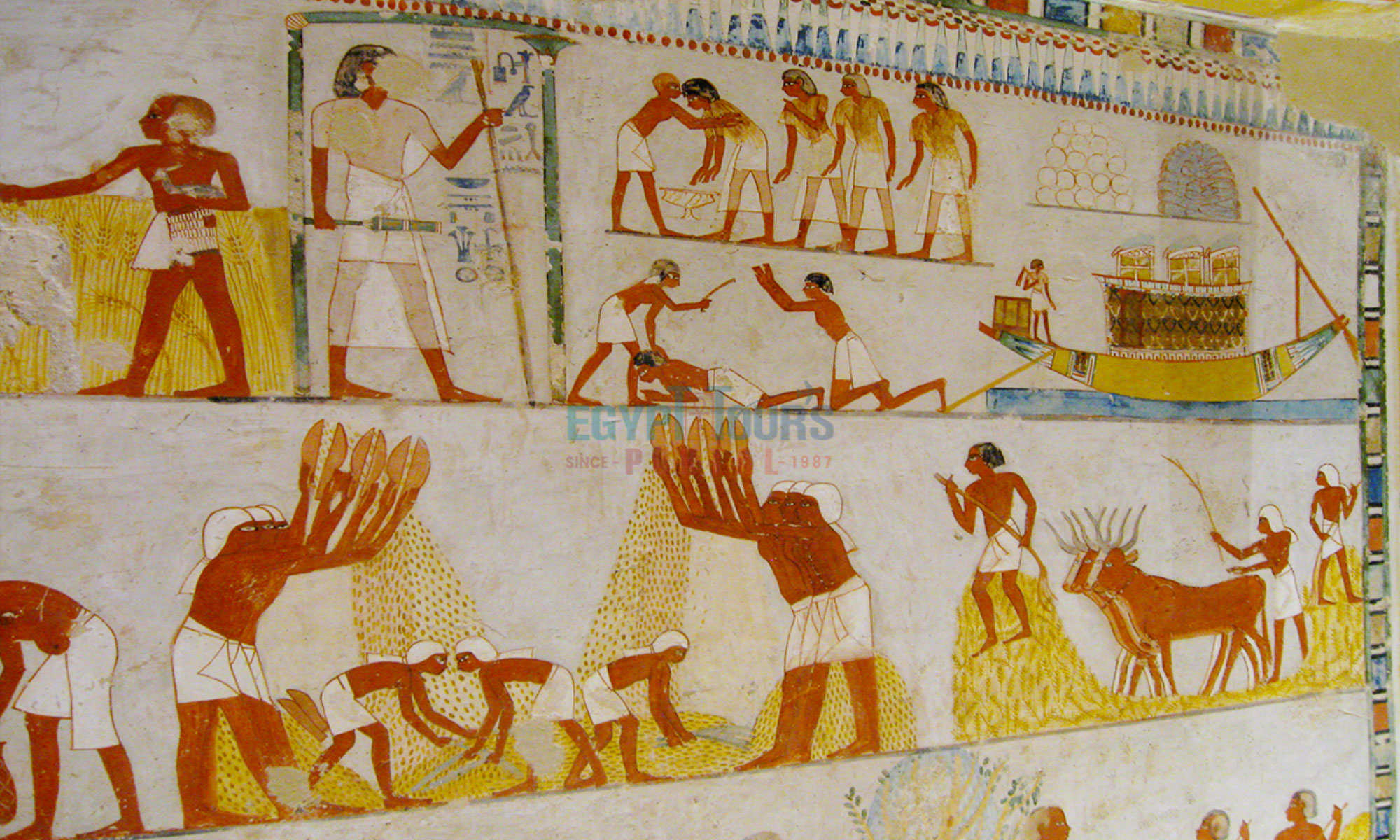
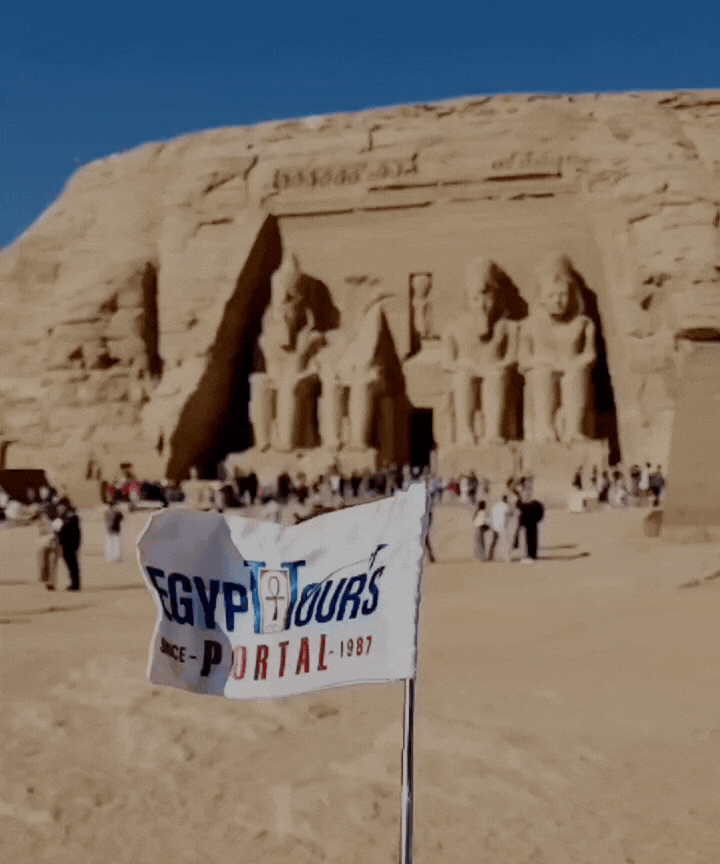
Ancient Egypt's thriving civilization was built on the foundation of a highly organized and diverse workforce, where every profession played a vital role in sustaining society. From the pharaohs and priests at the pinnacle of the hierarchy to the farmers and laborers who toiled in the fields, each occupation reflected the intricate social structure and cultural values of the time.
Everyone will dive deep into the fascinating world of ancient Egyptian occupations, exploring how their economy, religion, and artistry flourished through specialized trades. By examining the daily lives, responsibilities, and achievements of workers across all classes, we uncover the ingenuity and resilience of this extraordinary civilization. Through their collective efforts, the people of ancient Egypt created one of history's most enduring legacies.

Ancient Egyptian society was characterized by a rigid hierarchical structure, with occupations reflecting one’s social status. At the top stood the pharaoh, regarded as a divine ruler responsible for maintaining ma’at, the cosmic balance. Below the pharaoh were the nobility, including viziers, high-ranking officials, and priests, who administered governance, led rituals, and oversaw monumental projects. For example, Imhotep, the vizier of Djoser in the 27th century BCE, not only managed state affairs but also designed the Step Pyramid at Saqqara, reflecting the integration of governance and innovation.
Scribes formed another important tier, serving as record keepers, tax collectors, and administrators. Artisans and craftsmen occupied the middle tier, creating the tools, jewelry, and sculptures that defined Egyptian culture. Farmers and laborers, the majority of the population, formed the backbone of the economy, sustaining the state through agricultural output and contributions to monumental construction projects.
Professions in ancient Egypt were often inherited, with children typically following in their parents' footsteps. This system ensured continuity and stability but limited upward mobility. However, literacy offered a rare opportunity for advancement. A farmer’s son, for instance, could rise in status if he trained as a scribe. This opportunity became especially significant during stable periods such as the Middle Kingdom (c. 2055–1650 BCE), when the state heavily relied on a well-organized bureaucracy.
Discover the hierarchical structure and facts relating to the Ancient Egyptian craftsmen.
Read More
Agriculture was the lifeblood of ancient Egypt, sustaining its economy and supporting its monumental state projects. Farmers played a critical role, growing staples like wheat and barley alongside vegetables, fruits, and flax for linen production. The agricultural calendar revolved around the flooding of the Nile, which created fertile soil for cultivation. The Egyptian Calendar was divided into three key seasons: Akhet (inundation), when fields were flooded and farmers contributed to state projects; Peret (planting), when crops were sown; and Shemu (harvesting), when grain and other produce were collected.
The Nile's flooding was both a blessing and a potential threat. During the First Intermediate Period (c. 2181–2055 BCE), inadequate flooding caused widespread famine and societal unrest. Farmers worked tirelessly, often assisted by their families, to ensure a good harvest. Their labor was taxed heavily, with a portion of their produce going to the state. Despite their grueling work, farmers’ contributions were celebrated in festivals, which provided them with respite and honored their role in sustaining Egypt’s prosperity.
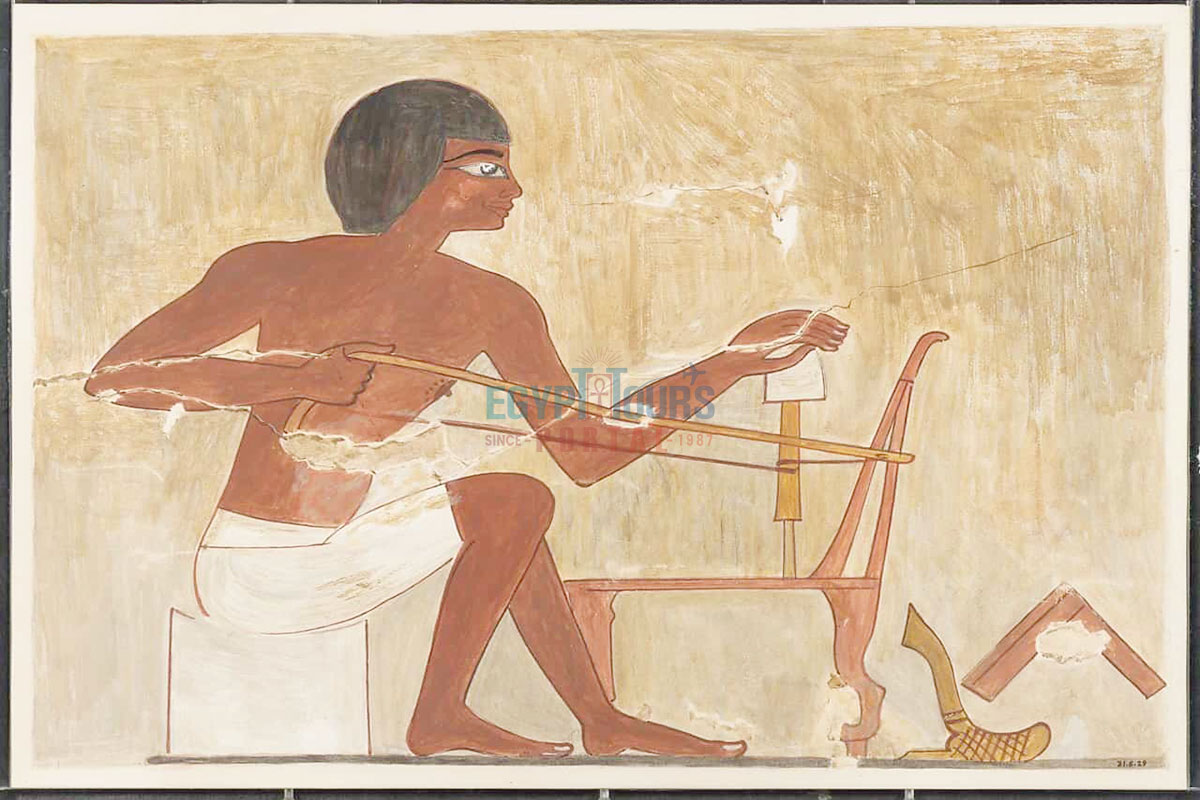
Artisans and craftsmen were the creators of the remarkable goods that symbolized ancient Egypt’s cultural and artistic achievements. Their work ranged from pottery and jewelry making to sculpture and monumental art. Pottery, for instance, evolved significantly over time, from the black-topped red ware of the Naqada I period (c. 4000–3500 BCE) to the intricately painted blue ceramics of the New Kingdom (c. 1550–1070 BCE). Jewelry makers fashioned exquisite pieces, such as the golden death mask of Tutankhamun (1323 BCE), which showcased the sophistication of Egyptian goldsmithing.
Artisans typically worked in workshops, often organized into teams that resembled guilds. State-controlled workshops like those at Deir el-Medina provided stable employment for skilled laborers tasked with creating Ancient Egyptian tombs and Egyptian temples. These artisans were highly respected for their expertise, and their contributions were immortalized in structures like the temples of Luxor and Karnak, where their craftsmanship can still be admired today.
Explore the meaningful art and creative skill of the Egyptians Artisans.
Read More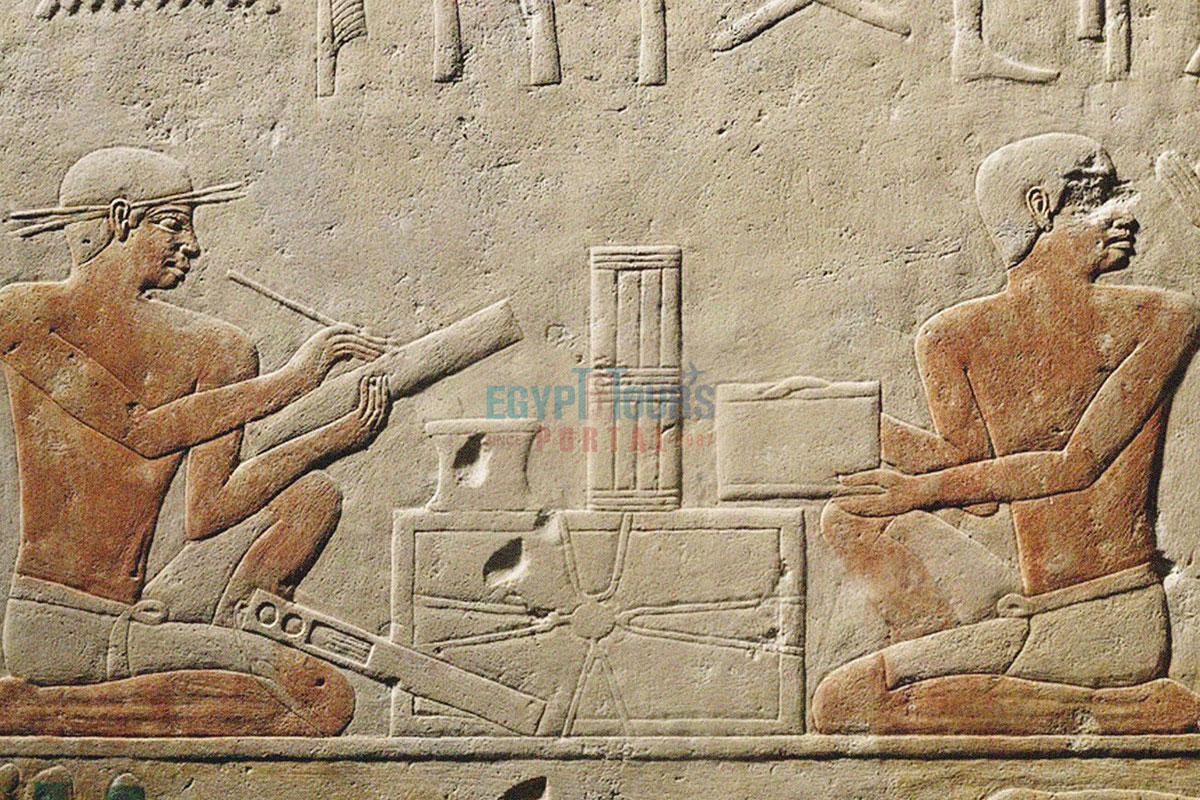
Scribes held a prestigious position in ancient Egypt, serving as the backbone of the state’s bureaucracy. Their training was rigorous, beginning at specialized schools where they mastered over 700 hieroglyphic symbols. Advanced training often occurred in temple schools, known as Houses of Life, where scribes learned mathematics, astronomy, and medicine. Texts like the Instructions of Ptahhotep (c. 2350 BCE) not only honed their writing skills but also instilled moral and ethical values.
Scribes performed a wide range of duties. They maintained tax records, documented legal proceedings, and kept track of agricultural yields. In addition to administrative roles, scribes contributed to religious life by composing texts such as the Pyramid Texts (c. 2400–2300 BCE) and the Book of the Dead (c. 1550 BCE), which guided the deceased through the afterlife. Their literacy and administrative skills granted them access to wealth and privilege, and they were often exempt from taxes and manual labor.

Priests in ancient Egypt played a vital role as intermediaries between the people and the gods of Ancient Egypt. The priesthood was highly stratified, with ranks ranging from the high priest, who oversaw temple complexes like Karnak, to temple priests who conducted daily rituals. Specialist priests, such as lector priests, recited sacred texts, while others performed roles as healers or astronomers. Temples were more than religious centers; they were hubs of economic activity, storing surplus grain, gold, and other valuable goods.
Priests performed elaborate daily rituals to maintain ma’at. This included offering food and incense to divine statues, cleaning them, and adorning them with fine linens and jewelry. Temples like Abu Simbel and the Temple of Hathor at Dendera required constant upkeep, underscoring the priests’ importance. Festivals such as the Opet Festival highlighted their role in uniting the people through shared religious experiences.
Learn all that you can about the Religion of Ancient Egypt.
Read More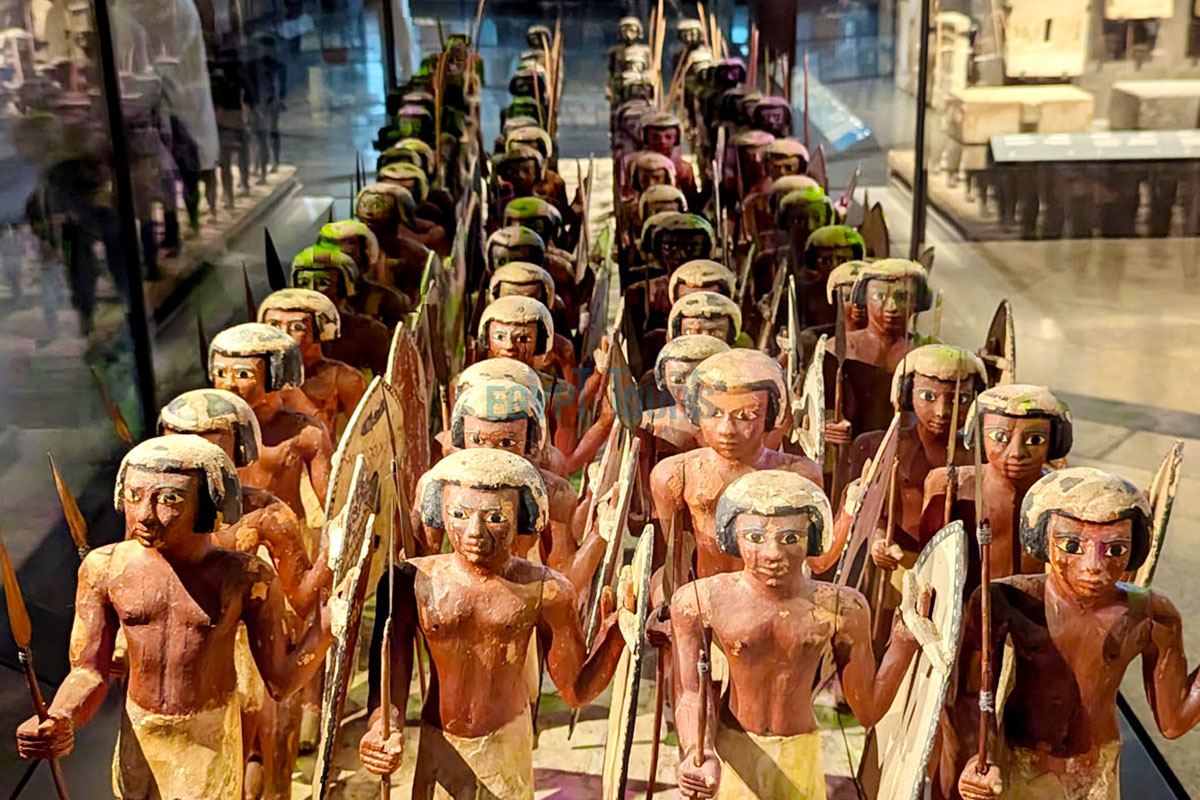
The military was a cornerstone of ancient Egypt’s power, defending its borders and enabling territorial expansion. Soldiers were often recruited from the general population, with training camps teaching archery, swordsmanship, and chariotry. The introduction of chariots during the Second Intermediate Period (c. 1650–1550 BCE) revolutionized Egyptian warfare and changed the course of Ancient Egyptian Battles. By the time of Thutmose III (c. 1479–1425 BCE), Egypt’s army was one of the most advanced in the ancient world.
Military service offered opportunities for social mobility. A soldier who distinguished himself in battle could rise through the ranks, potentially becoming a general or even a royal advisor. Veterans were rewarded with land grants and pensions, making military service an attractive option for ambitious young men.

Ancient Egyptian Entertainment was filled with musicians, dancers, and acrobats enlivening the Ancient Egyptian festivals and daily life of Ancient Egypt. Music was deeply tied to religion, with instruments like harps, flutes, and sistra accompanying temple rituals. Dancers, especially women, were highly sought after for their grace and skill. Performers were often employed by temples, where their art served to honor the gods.
Entertainers could achieve significant status, as demonstrated by Isadora of Artemisia (c. 200 CE), who commanded substantial fees for her performances. They played an important role in state-sponsored events, providing respite for laborers and enhancing communal celebrations.
The diversity of professions in ancient Egypt reflects the complexity and ingenuity of this remarkable civilization. From the pharaohs and priests who upheld divine order to the farmers and artisans who built its economic foundation, every occupation was considered a vital contribution to the harmony of the land.
The lasting achievements of the Egyptians, from their monumental architecture to their intricate art, were made possible by the dedication and expertise of their workforce. Through a deep understanding of their professions, we gain a richer appreciation for the society that built one of history’s most enduring empires. Explore all that this innovative and genuine culture has to offer and enjoy one of our epic Egypt holiday packages and Nile Cruise holidays.
Private 4 Days Cairo Tour Packages for British Travelers 4 days Cairo Egypt Tour pac...
Tour Location: Cairo – Giza...
5 Days Cairo and Alexandria Tour Package For British Travelers 5 days Cairo and Alex...
Tour Location: Cairo/Giza/Alexandria...
6 Days Cairo, Luxor & Aswan Tour Package For British Travelers 6 days Cairo, Lux...
Tour Location: Cairo/Giza/Aswan/Luxor...
Amazing 7 Days Cairo and Hurghada Holiday for British Travelers 7 Days Cairo & H...
Tour Location: Cairo – Giza – Hurgh...
The primary jobs included farmers, artisans, scribes, priests, soldiers, laborers, merchants, physicians, and entertainers. Each profession played a specific role in sustaining the society.
Farming was the most common occupation, as agriculture was the backbone of the economy. Farmers cultivated crops like wheat and barley and managed livestock.
Scribes were responsible for record-keeping, tax collection, writing official documents, and preserving religious and literary texts. They were highly respected and well-educated.
Most jobs were inherited, with children often following their parents' professions. However, exceptional talent or training could provide opportunities for advancement, especially for scribes and soldiers.
Artisans created pottery, jewelry, sculptures, and furniture. They worked in workshops and were crucial in constructing temples, tombs, and other monuments.
Priests maintained temples, performed rituals, and acted as intermediaries between the gods and the people. They also played roles in education and administration.
Yes, physicians treated illnesses, conducted surgeries, and created remedies using herbs and other natural resources. Medical knowledge was advanced and recorded in texts like the Ebers Papyrus.
Women worked as weavers, midwives, musicians, dancers, priestesses, and even administrators. Wealthier women managed households, while poorer women often worked alongside their husbands.
Soldiers protected Egypt's borders, participated in military campaigns, and helped maintain internal security. They were often rewarded with land and wealth.
Laborers were organized into teams to construct pyramids, temples, and tombs. They received wages in the form of food, beer, and other goods, and lived in nearby workers’ villages.
Merchants facilitated trade within Egypt and with neighboring regions, exchanging goods like gold, papyrus, linen, and grain for incense, ivory, and exotic goods.
Entertainers included musicians, dancers, acrobats, and storytellers who performed at festivals, religious ceremonies, and private gatherings.
Many jobs depended on the Nile, such as farming, fishing, and transportation. The river's annual flooding provided fertile soil and influenced the agricultural calendar.
Yes, there were specialists in fields like medicine, architecture, and jewelry making. These roles required training and often came with higher status.
Jobs like scribes, priests, and artisans were well-respected, while laborers and farmers held lower social status. Soldiers and merchants could improve their status through success in their roles.
The entire country of Egypt deserve to be explored with its every heavenly detail but there are places that must be seen before any other such as the breathtaking Hurghada's red sea, The wonders of Cairo the pyramids of Giza, the great sphinx, the Egyptian Museum, Khan El Khalili Bazaar, the wonders of Luxor like Valley of the Kings, Karnak & Hatshepsut temple and the wonders of Aswan such as Abu Simbel temples, Philea temple, Unfinished obelisk and The Wonders of Alexandria like Qaitbat Citadel, Pompey's Pillar and Alexandria Library. Read more about the best places to visit in Egypt.
If you want to apply for a Visa On Arrival that lasts for 30 days then you should be one of the eligible countries, have a valid passport with at least 6 months remaining and pay 25$ USD in cash, as for the E-Visa for 30 day you should have a valid passport for at least 8 months, complete the online application, pay the e-visa fee then print the e-visa to later be presented to the airport border guard. You could also be one of the lucky ones who can obtain a free visa for 90 days. Read more about Egypt travel visa.
Egypt has a variety of delicious cuisines but we recommend “Ful & Ta’meya (Fava Beans and Falafel)”, Mulukhiya, “Koshary”, a traditional Egyptian pasta dish, and Kebab & Kofta, the Egyptian traditional meat dish.
The best time to travel to Egypt is during the winter from September to April as the climate becomes a little tropical accompanied by a magical atmosphere of warm weather with a winter breeze. You will be notified in the week of your trip if the Climate is unsafe and if any changes have been made.
You should pack everything you could ever need in a small bag so you could move easily between your destinations.
We have been creating the finest vacations for more than 20 years around the most majestic destinations in Egypt. Our staff consists of the best operators, guides and drivers who dedicate all of their time & effort to make you have the perfect vacation. All of our tours are customized by Travel, Financial & Time consultants to fit your every possible need during your vacation. It doesn't go without saying that your safety and comfort are our main priority and all of our resources will be directed to provide the finest atmosphere until you return home.
You will feel safe in Egypt as the current atmosphere of the country is quite peaceful after the government took powerful measures like restructuring the entire tourist police to include all the important and tourist attractions in Egypt. Read more about is it safe to travel to Egypt.
Wear whatever feels right and comfortable. It is advised to wear something light and comfortable footwear like a closed-toe shoe to sustain the terrain of Egypt. Put on sun block during your time in Egypt in the summer to protect yourself from the sun.
The best activity is by far boarding a Nile Cruise between Luxor and Aswan or Vise Versa. Witness the beauty of Egypt from a hot balloon or a plane and try all the delicious Egyptian cuisines and drinks plus shopping in old Cairo. Explore the allure and wonders of the red sea in the magical city resorts of Egypt like Hurghada and many more by diving and snorkeling in the marine life or Hurghada. Behold the mesmerizing western desert by a safari trip under the heavenly Egyptian skies.
There are a lot of public holidays in Egypt too many to count either religious or nation, the most important festivals are the holy month of Ramadan which ends with Eid Al Fitr, Christmas and new years eve. Read more about festivals & publich holidays in Egypt.
Egypt is considered to be one of the most liberal Islamic countries but it has become a little bit conservative in the last couple of decades so it is advised to avoid showing your chest, shoulders or legs below the knees.
Arabic is the official language and Most Egyptians, who live in the cities, speak or understand English or at least some English words or phrases. Fewer Egyptians can speak French, Italian, Spanish, and German. Professional tour guides, who work in the tourism sector, are equipped to handle visitors who cannot speak Arabic and they will speak enough English and other languages to fulfill the needs of all our clients.
The fastest way is a car, of course, a taxi. If you are in Cairo ride a white taxi to move faster or you could board the fastest way of transportation in Egypt metro if the roads are in rush hour.
The temperature in Egypt ranges from 37c to 14 c. Summer in Egypt is somehow hot but sometimes it becomes cold at night and winter is cool and mild. The average of low temperatures vary from 9.5 °C in the wintertime to 23 °C in the summertime and the average high temperatures vary from 17 °C in the wintertime to 32 °C in the summertime. The temperature is moderate all along the coasts.
It is the home of everything a traveler might be looking for from amazing historical sites dating to more than 4000 years to enchanting city resorts & beaches. You will live the vacation you deserve as Egypt has everything you could possibly imagine.









